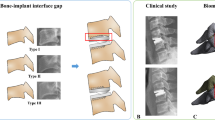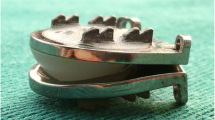Abstract
Purpose
Few finite element studies have investigated changes in cervical biomechanics with various prosthesis design parameters using hybrid surgery (HS), and none have investigated those combined different HS strategies. The aim of our study was to investigate the effect of ball-and-socket prosthesis geometry on the biomechanical performance of the cervical spine combined with two HS constructs.
Methods
Two HS strategies were conducted: (1) ACDF at C4–C5 and anterior cervical disc replacement (ACDR) at C5–C6 (ACDF/ACDR), and (2) ACDR/ACDF. Three different prostheses were used for each HS strategy: prosthesis with the core located at the center of the inferior endplate with a radius of 5 mm (BS-5) or 6 mm (BS-6), or with a 5 mm radius core located 1 mm posterior to the center of the inferior endplate (PBS-5). Flexion and extension motions were simulated under displacement control.
Results
The flexion motions in supra- and infra-adjacent levels increased in all cases. The corresponding extension motions increased with all prostheses in ACDR/ACDF group. The stiffness in flexion and extension increased with all HS models, except for the extension stiffness with ACDF/ACDR. The facet stresses between the index and infra-adjacent level in ACDR/ACDF were significantly greater than those in the intact model . The stresses on the BS-5 UHMWPE core were greater than the yield stress.
Conclusion
The core radii and position did not significantly affect the moments, ROM, and facet stress in extension. However, the moments and ROM in flexion were easily affected by the position. The results implied that the large core radii and posterior core position in ACDR designs may reduce the risk of subsidence and wear in the long term as they showed relative low stress . The ACDF/ACDR surgery at C4–C6 level may be an optimal treatment for avoiding accelerating the degeneration of adjacent segments.








Similar content being viewed by others
References
Matsumoto M, Okada E, Ichihara D, Watanabe K, Chiba K, Toyama Y (2010) Adjacent segment disease and degeneration after anterior cervical decompression and fusion. Neurosurg Q 20:15–22. doi:10.1097/WNQ.0b013e3181ce0d13
Hilibrand AS, Robbins M (2004) Adjacent segment degeneration and adjacent segment disease: the consequences of spinal fusion? The spine J 4:190S–194S. doi:10.1016/j.spinee.2004.07.007
Park DK, Lin EL, Phillips FM (2011) Index and adjacent level kinematics after cervical disc replacement and anterior fusion in vivo quantitative radiographic analysis. Spine 36:721–730. doi:10.1097/BRS.0b013e3181df10fc
McDonald CP, Chang V, McDonald M, Ramo N, Bey MJ, Bartol S (2014) Three-dimensional motion analysis of the cervical spine for comparison of anterior cervical decompression and fusion versus artificial disc replacement in 17 patients. J Neurosurg Spine 20:245–255. doi:10.3171/2013.11.SPINE13392
Eck JC, Humphreys SC, Lim TH, Jeong ST, Kim JG, Hodges SD, An HS (2002) Biomechanical study on the effect of cervical spine fusion on adjacent-level intradiscal pressure and segmental motion. Spine 27:2431–2434. doi:10.1097/01.BRS.0000031261.66972.B1
Dmitriev AE, Cunningham BW, Hu NB, Sell G, Vigna F, McAfee PC (2005) Adjacent level intradiscal pressure and segmental kinematics following a cervical total disc arthroplasty — an in vitro human cadaveric model. Spine 30:1165–1172. doi:10.1097/01.brs.0000162441.23824.95
Rabin D, Pickett GE, Bisnaire L, Duggal N (2007) The kinematics of anterior cervical discectomy and fusion versus artificial cervical disc: a pilot study. Neurosurgery 61S:100–104. doi:10.1227/01.NEU.0000279997.11201.B4
Sasso RC, Smucker JD, Hacker RJ, Heller JG (2007) Artificial disc versus fusion a prospective, randomized study with 2-year follow-up on 99 patients. Spine 32:2933–2940
Shi J, Lin B, Xue C, Zhang H, Chen Z, Zhao Z (2015) Clinical and radiological outcomes following hybrid surgery in the treatment of multi-level cervical spondylosis: over a 2-year follow-up. J Orthop Surg Res 10(1):185. doi:10.1186/s13018-015-0330-5
Grasso G (2015) Clinical and radiological features of hybrid surgery in multilevel cervical degenerative disc disease. Eur Spine J 247:S842–S848. doi:10.1007/s00586-015-4281-7
Gandhi AA, Kode S, DeVries NA, Grosland NM, Smucker JD, Fredericks DC (2015) Biomechanical analysis of cervical disc replacement and fusion using single level, two level, and hybrid constructs. Spine 40:1578–1585. doi:10.1097/BRS.0000000000001044
Liu B, Zeng Z, Van Hoof T, Kalala JP, Liu Z, Wu B (2015) Comparison of hybrid constructs with 2-level artificial disc replacement and 2-level anterior cervical discectomy and fusion for surgical reconstruction of the cervical spine: a kinematic study in whole cadavers. Med Sci Monit 21:1031–1037
Jia Z, Mo Z, Ding F, He Q, Fan Y, Ruan D (2014) Hybrid surgery for multilevel cervical degenerative disc diseases: a systematic review of biomechanical and clinical evidence. Eur Spine J 23:1619–1632. doi:10.1007/s00586-014-3389-5
Chung T, Hueng D, Lin S (2015) Hybrid strategy of two-level cervical artificial disc and intervertebral cage biomechanical effects on tissues and implants. Medicine doi:10.1097/MD.0000000000002048
Rousseau M, Bonnet X, Skalli W (2008) Influence of the geometry of a ball-and-socket intervertebral prosthesis at the cervical spine–a finite element study. Spine 33:E10–E14
Faizan A, Goel VK, Garfin SR, Bono CM, Serhan H, Biyani A, Elgafy H, Krishna M, Friesem T (2012) Do design variations in the artificial disc influence cervical spine biomechanics? A finite element investigation. Eur Spine J 21(Suppl 5):S653–S662. doi:10.1007/s00586-009-1211-6
Womack W, Leahy PD, Patel VV, Puttlitz CM (2011) Finite element modeling of kinematic and load transmission alterations due to cervical intervertebral disc replacement. Spine 36:E1126–E1133. doi:10.1097/BRS.0b013e31820e3dd1
Li Y, Fogel GR, Liao Z, Tyagi R, Zhang G, Liu W (2017) Biomechanical analysis of two-level cervical disc replacement with a stand-alone U-shaped disc implant. Spine. doi:10.1097/BRS.0000000000002128
Mo Z, Zhao Y, Du C, Sun Y, Zhang M, Fan Y (2015) Does location of rotation center in artificial disc affect cervical biomechanics? Spine 40:E469–E475
Mo Z, Li Q, Jia Z, Yang J, Wong DW, Fan Y (2016) Biomechanical consideration of prosthesis selection in hybrid surgery for bi-level cervical disc degenerative diseases. Eur Spine J 26:1181–1190. doi:10.1007/s00586-016-4777-9
Kumaresan S, Yoganandan N, Pintar FA, Maimam DJ (1999) Finite element modeling of the cervical spine: role of intervertebral disc under axial and eccentric loads. Med Eng Phys 21(10):689–700. doi:10.1016/S1350-4533(00)00002-3
Ganbat D, Kim YH, Kim K, Jin YJ, Park WM (2016) Effect of mechanical loading on heterotopic ossification in cervical total disc replacement: a three-dimensional finite element analysis. Biomech Model Mechanobiol 15:1191–1199. doi:10.1007/s10237-015-0752-3
Mo ZJ, Bin Zhao Y, Wang LZ, Sun Y, Zhang M, Fan YB (2014) Biomechanical effects of cervical arthroplasty with U-shaped disc implant on segmental range of motion and loading of surrounding soft tissue. Eur Spine J 23:613–621. doi:10.1007/s00586-013-3070-4
Panzer MB, Cronin DS (2009) C4–C5 segment finite element model development, validation, and load-sharing investigation. J Biomech 42:480–490. doi:10.1016/j.jbiomech.2008.11.036
Lee S, Im Y, Kim K, Kim Y, Park W, Kim K (2011) Comparison of cervical spine biomechanics after fixed-and mobile-core artificial disc replacement: a finite element analysis. Spine 36:700–708. doi:10.1097/BRS.0b013e3181f5cb87
Panjabi MM, Crisco JJ, Vasavada A, Oda T, Cholewicki J, Nibu K, Shin E (2001) Mechanical properties of the human cervical spine as shown by three-dimensional load-displacement curves. Spine 26:2692–2700. doi:10.1097/00007632-200112150-00012
Wheeldon JA, Stemper BD, Yoganandan N, Pintar FA (2008) Validation of a finite element model of the young normal lower cervical spine. Ann Biomed Eng 36:1458–1469. doi:10.1007/s10439-008-9534-8
Cho BY, Lim J, Sim HB, Park J (2010) Biomechanical analysis of the range of motion after placement of a two-level cervical pro disc-C versus hybrid construct. Spine 35:1769–1776. doi:10.1097/BRS.0b013e3181c225fa
Barrey C, Campana S, Persohn S, Perrin G, Skalli W (2012) Cervical disc prosthesis versus arthrodesis using one-level, hybrid and two-level constructs: an in vitro investigation. Eur Spine J 21:432–442. doi:10.1007/s00586-011-1974-4
Park J, Shin JJ, Lim J (2014) Biornechanical analysis of disc pressure and facet contact force after simulated two-level cervical surgeries (fusion and arthroplasty) and hybrid surgery. World Neurosurg. doi:10.1016/j.wneu.2014.06.013
Lee MJ, Dumonski M, Phillips FM, Voronov LI, Renner SM, Carandang G, Havey RM, Patwardhan AG (2011) Disc replacement adjacent to cervical fusion a biomechanical comparison of hybrid construct versus two-level fusion. Spine 36:1932–1939. doi:10.1097/BRS.0b013e3181fc1aff
Cunningham BW, Hu N, Zorn CM, McAfee PC (2010) Biomechanical comparison of single- and two-level cervical arthroplasty versus arthrodesis: effect on adjacent-level spinal kinematics. Spine J 10:341–349. doi:10.1016/j.spinee.2010.01.006
Pan L, Yang X, Gu L, Lu W, Fang M (2011) Validation and prediction of traditional Chinese physical operation on spinal disease using multiple deformation models. Int J Comput Assist Radiol 6:201–208. doi:10.1007/s11548-010-0500-1
Acknowledgements
This work was supported by the Industry Public Technology Service Platform Capital Projects of Shenzhen [Grant Number SMJKPT20140417010001] and the Science and Technology Plan Basic Research Project of Shenzhen [Grant Number JCYJ20151030160526024]. The participant was explained on the research purpose and signed the consent form.
Author information
Authors and Affiliations
Corresponding author
Ethics declarations
Conflict of interest
The authors declare that they have no conflict of interest.
Ethical approval
All procedures performed in studies involving human participants were in accordance with the ethical standards of the institutional and/or national research committee and with the 1964 Helsinki declaration and its later amendments or comparable ethical standards.
Informed consent
This article does not contain patient data.
Rights and permissions
About this article
Cite this article
Li, Y., Fogel, G.R., Liao, Z. et al. Finite element model predicts the biomechanical performance of cervical disc replacement and fusion hybrid surgery with various geometry of ball-and-socket artificial disc. Int J CARS 12, 1399–1409 (2017). https://doi.org/10.1007/s11548-017-1616-3
Received:
Accepted:
Published:
Issue Date:
DOI: https://doi.org/10.1007/s11548-017-1616-3




